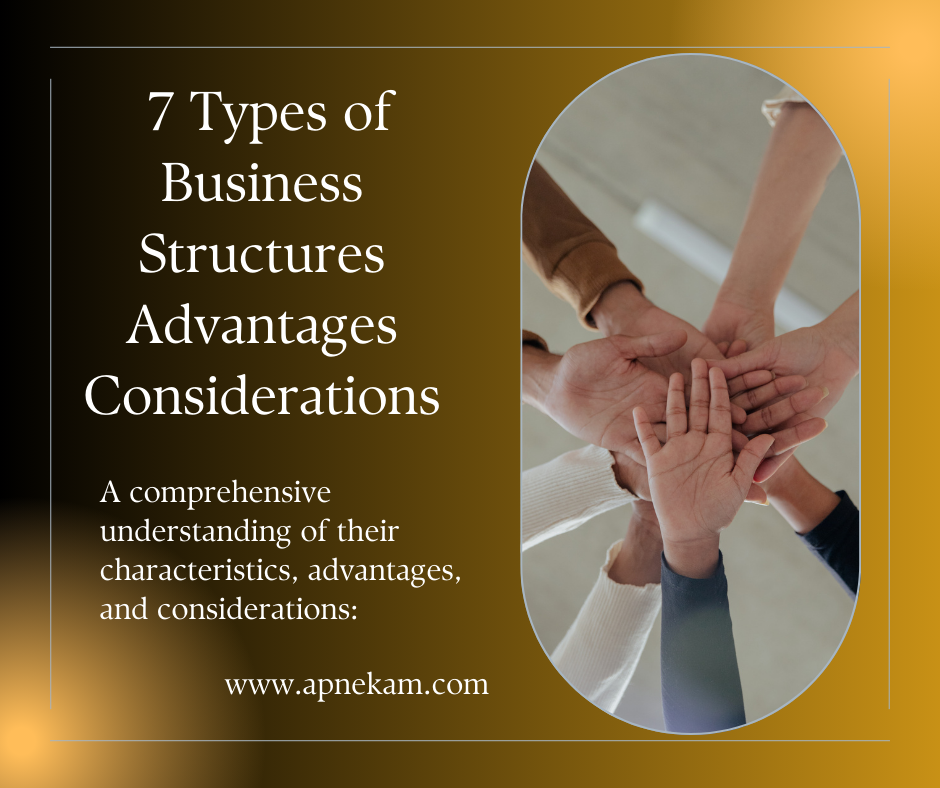
Welcome to Types of the Business, your ultimate guide to navigating the intricate world of business structures. If you’re someone who’s eager to start their own venture but feels overwhelmed by the various options available, you’ve come to the right place! Today, let’s unravel the mystery behind the seven most common types of business structures and shed light on what sets each one apart.
1. Sole Proprietorship:
- Description: In a sole proprietorship, a single individual owns and operates the business. It is the easiest type of business element and doesn’t need formal enlistment.
- Advantages:
- Easy to set up and operate.
- Full control over business decisions.
- Direct ownership of profits.
- Considerations:
- Unlimited personal liability for business debts.
- Limited opportunities for raising capital.
- Limited lifespan tied to the owner’s involvement.
2. General Partnership:
- Description: A general partnership involves two or more individuals who agree to share ownership, profits, and liabilities of the business.
- Advantages:
- Shared management responsibilities and workload.
- Combined resources and expertise.
- Flexible decision-making process.
- Considerations:
- Each partner is personally liable for the partnership’s debts.
- Potential conflicts and disagreements among partners.
- Dissolution of the partnership in case of partner withdrawal or death.
3. Limited Partnership (LP):
- Description: A limited partnership consists of one or more general partners who manage the business and one or more limited partners who contribute capital but have limited involvement in management.
- Advantages:
- Limited liability protection for limited partners.
- Flexibility in investment and management roles.
- Potential tax benefits for limited partners.
- Considerations:
- General partners have unlimited personal liability.
- Limited partners have restricted control over business decisions.
- Complex legal and regulatory requirements.
4. Corporation:
- Description: A corporation is a legal entity separate from its owners (shareholders), offering limited liability protection and perpetual existence.
- Advantages:
- Limited liability protection for shareholders.
- Ability to raise capital through the sale of stock.
- Continuity of existence beyond shareholder changes.
- Considerations:
- Double taxation on corporate profits (unless an S Corporation).
- Complex formation and ongoing compliance requirements.
- Formal design with a governing body and officials..
5. Limited Liability Company (LLC):
- Description: An LLC combines the liability protection of a corporation with the flexibility and tax benefits of a partnership, allowing owners (members) to avoid double taxation.
- Advantages:
- Limited personal liability for members.
- Pass-through taxation (unless elected otherwise).
- Flexible management structure and operating agreements.
- Considerations:
- Formation and operational costs may be higher than other structures.
- State-specific regulations and requirements.
- Limited life span if not properly structured for continuity.
6. Nonprofit Organization:
- Description: Nonprofits are mission-driven entities dedicated to serving the community, pursuing charitable, educational, religious, or social goals.
- Advantages:
- Tax-exempt status for qualifying activities.
- Eligibility for grants, donations, and other funding sources.
- Ability to make a positive social impact.
- Considerations:
- Compliance with strict IRS regulations and reporting requirements.
- Limited ability to generate profits for owners or shareholders.
- Restrictions on political and lobbying activities.
7. Cooperative (Co-op):
- Description: A cooperative is owned and operated by its members, who share ownership, decision-making authority, and often, profits.
- Advantages:
- Democratic governance structure with equal member voting rights.
- Shared resources and risk among members.
- Potential for cost savings and collective bargaining power.
- Considerations:
- Limited access to external financing and capital.
- Potential for conflicts and disagreements among members.
- Balancing individual and collective interests.
Conclusion: Choosing the Right Structure for Your Business
In conclusion, each type of business structure offers unique benefits and challenges, so it’s essential to carefully evaluate your goals, resources, and preferences before selecting the one that best fits your needs. Talking with lawful and monetary experts can give significant direction in settling on this significant choice.
I hope this guide has provided you with valuable insights into the various types of business structures and empowered you to make the best decision for your entrepreneurial journey. Remember, there’s no one-size-fits-all approach, so take your time, do your research, and choose the structure that aligns with your vision and objectives. Here’s to your future success as a business owner!
